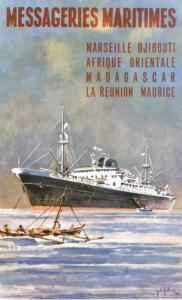Founder Albert Rostand | Founded 1835 | |
 | ||
Ms georges philippar messageries maritimes
Messageries maritimes was a French merchant shipping company. It was originally created in 1851 as Messageries nationales, later called Messageries impériales, and from 1871, Compagnie des messageries maritimes, casually known as "MesMar" or by its initials "MM". Its rectangular house flag, with the letters MM on a white background and red corners, was famous in shipping circles, especially on the Europe-Asia trade lanes . In 1977 it merged with Compagnie générale transatlantique to form Compagnie générale maritime. In 1996 CGM was privatized and sold to Compagnie Maritime d'Affrètement (CMA) to form CMA CGM.
Contents
- Ms georges philippar messageries maritimes
- S s andre lebon messageries maritimes king oliver s orchestra
- Company history
- References
S s andre lebon messageries maritimes king oliver s orchestra
Company history
In 1851 a ship owner from Marseille, Albert Rostand, proposed to Ernest Simons, director of a terrestrial carrier company, the Messageries mationales, to merge to create a shipping company, first called Messageries nationales, then Messageries impériales, and finally in 1871 the Compagnie des messageries maritimes. Two engineers, Henri Dupuy de Lôme and Armand Béhic joined the company, encouraging the purchase of the shipbuilding yards of La Ciotat in 1849.
In the beginning the Company operated on routes to the Middle East. Its ships were used as troopships during the Crimean War, and were so helpful for the army that the Emperor gave the company the right to operate on the Bordeaux – Brazil route as thanks. This was the first French transatlantic line equipped with steamers. The following year, the Société générale maritime (future Compagnie générale transatlantique) received the North Atlantic lines.
From 1871 to 1914 the Compagnie des messageries maritimes saw its golden age. This was the period of French colonial expansion and of interventionism in the Middle and Far East. The Marseille liners continuously served in the Mediterranean Sea, the Black Sea, then the Red Sea, the Indian Ocean, the China Sea and finally the Pacific Ocean. In the west, the South Atlantic line filled out. Even the North Atlantic knew the ships with the typical double funnel, which worked the route London – Dunkirk – Le Havre – Marseille. In the Middle East, the ports of call were Malta, Alexandria, Port Said, Beirut, Syria, Smyrna, Constantinople, and the Black Sea. In the Indian Ocean, the line served Mahé, Seychelles, La Réunion, Mauritius, Zanzibar and Madagascar as well as the French establishments in India. At Pondicherry the small harbour necessitated the use of ship's tenders.
The Far East was the private field of the company. Saigon was rapidly becoming the second home port of the company. The "stationnaires", ships of small tonnage, afforded to the local lines departed from there. They went to Hanoi, Hong Kong, Shanghai, Australia and New Caledonia.
In the South Atlantic, the Brazil line went as far as Montevideo. Less important, and less known, its home port was Bordeaux.
Ships of this line were some of the first large vessels to be fitted with the new water-tube boilers, specifically the large-tube Belleville boiler. Their performance was of such interest to the British Royal Navy that the Jerseyman Edouard Gaudin, who could pass for French, was sent to investigate their use. His report was an influence on their fitment to new ships, the Powerful-class cruisers HMS Powerful & Terrible.
